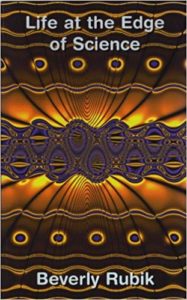Book review by David Lorimer

Life at the Edge of Science
Beverly Rubik
Institute for Frontier Science, 1996, 185 pp., $16.00
ISBN 0-9652401-0-X
Beyond Paradigm Paralysis
Beverly Rubik has been at the heart of frontier sciences for around a decade in her capacity as director of the Center for Frontier Sciences at Temple University and now of the Institute for Frontier Science. She, therefore, has extensive knowledge in this field that covers biophysics, anomalistics, consciousness studies and complementary medicine. All these topics are treated in this book. She begins with considerations on the role of anomalies in science, which she regards as crucial to promoting continuous scientific innovation and breakthroughs. Instead of a state of ‘balanced openness’ recommended by the author, the reactions of orthodox scientists to anomalies are frequently hostile and defensive. This in itself is less surprising when one considers the personal costs of stepping out of the mainstream and being branded as a heretic: loss of funding, difficulty in publishing, loss of reputation, obstacles to advancement, critical backlash and even loss of employment. Rubik nevertheless puts forward guidelines for progress in frontier sciences and holds out the hope of acceptance of some research areas once assumptions are modified.
She characterizes such a change of assumptions both in terms of a new balance between masculine and feminine attitudes and a consensus around the following propositions: ‘consciousness is both primary and causal; evolution may be regarded as teleological; mind has properties that transcend space-time; life is far more than a mechanical reductionist bag of biomolecules; and the whole cosmos cannot be addressed by means of a reductionist approach’. Many of these propositions are borne out in consciousness studies, which forms the second part of the book and features an excellent inventory of qualities required in a science of consciousness.
The third part is devoted to biology and medicine. What she calls a real science of life would address subtle interconnections, new informational capacity in living matter, the role of consciousness in the material world; and an expanded view of the role of fields. She poses specific challenges to mechanistic biology and herself proposes an informational paradigm for the life sciences. The final chapter addresses limitations of the scientific paradigm for alternative medical research and shows once again how consciousness must be integrated into the picture. The book weaves together coherent strands in frontier sciences and can be recommended to any reader trying to make sense of the larger picture as it applies across the range of the emerging holistic science and medicine.